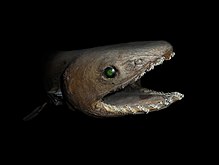
Back قرش مزركش Arabic قرش مزركش ARZ Мантиева акула Bulgarian Tauró serp Catalan Chlamydoselachus CEB Žralok límcový Czech Kravehaj Danish Kragenhai German Πτυχωτός καρχαρίας Greek Koluma ŝarko EO
| Frilled shark Temporal range:
| |
|---|---|

| |
| At the Palais de la Porte Dorée | |
| Scientific classification | |
| Domain: | Eukaryota |
| Kingdom: | Animalia |
| Phylum: | Chordata |
| Class: | Chondrichthyes |
| Subclass: | Elasmobranchii |
| Order: | Hexanchiformes |
| Family: | Chlamydoselachidae |
| Genus: | Chlamydoselachus |
| Species: | C. anguineus
|
| Binomial name | |
| Chlamydoselachus anguineus Samuel Garman, 1884
| |

| |
| Range of the frilled shark | |

The frilled shark (Chlamydoselachus anguineus), also known as the lizard shark, is one of the two extant species of shark in the family Chlamydoselachidae (the other is the southern African frilled shark, Chlamydoselachus africana). The frilled shark is considered a living fossil, because of its primitive, anguilliform (eel-like) physical traits, such as a dark-brown color, amphistyly (the articulation of the jaws to the cranium), and a 2.0 m (6.6 ft)–long body, which has dorsal, pelvic, and anal fins located towards the tail. The common name, frilled shark, derives from the fringed appearance of the six pairs of gill slits at the shark's throat.
The two species of frilled shark are distributed throughout regions of the Atlantic and the Pacific oceans, usually in the waters of the outer continental shelf and of the upper continental slope, where the sharks usually live near the ocean floor, near biologically productive areas of the ecosystem. To live on a diet of cephalopods, smaller sharks, and bony fish, the frilled shark practices diel vertical migration to feed at night at the surface of the ocean. When hunting food, the frilled shark curls its tail against a rock and moves like an eel, bending and lunging to capture and swallow whole prey with its long and flexible jaws, which are equipped with 300 recurved, needle-like teeth.[2]
Reproductively, the two species of frilled shark, C. anguineus and C. africana, are aplacental viviparous animals, born of an egg, without a placenta to the mother shark. Contained within egg capsules, the shark embryos develop in the body of the mother shark; at birth, the infant sharks emerge from their egg capsules in the uterus, where they feed on yolk. Although it has no distinct breeding season, the gestation period of the frilled shark can be up to 3.5 years long, to produce a litter of 2–15 shark pups. Usually caught as bycatch in commercial fishing, the frilled shark has some economic value as a meat and as fishmeal; and has been caught from depths of 1,570 m (5,150 ft), although its occurrence is uncommon below 1,200 m (3,900 ft); whereas in Suruga Bay, Japan, the frilled shark commonly occurs at depths of 50–200 m (160–660 ft).[3]
- ^ Smart, J.J.; Paul, L.J.; Fowler, S.L. (2016). "Chlamydoselachus anguineus". IUCN Red List of Threatened Species. 2016: e.T41794A68617785. doi:10.2305/IUCN.UK.2016-1.RLTS.T41794A68617785.en. Retrieved 19 November 2021.
- ^ Cite error: The named reference
ebertwas invoked but never defined (see the help page). - ^ Bray, Dianne J. (2011). "Frill Shark, Chlamydoselachus anguineus". FishesofAustralia.net.au. Archived from the original on 10 October 2014. Retrieved 7 October 2014.
